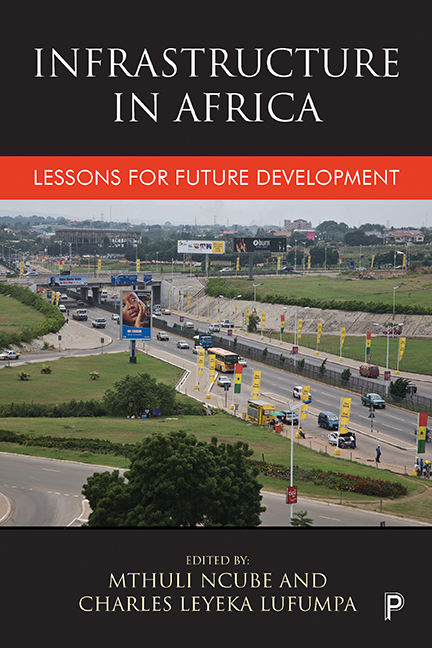Book contents
- Frontmatter
- Contents
- List of figures
- List of tables
- List of boxes
- Notes on contributors
- Acknowledgements
- Foreword
- Introduction: Infrastructure in African development
- Part 1 Spatial and demographic contexts
- Part 2 Sector-specific issues
- Part 3 Regional issues
- Part 4 Financing issues
- Part 5 Concluding remarks
- Index
eight - Africa’s prospects for infrastructure development and regional integration: information and communications technology sector
Published online by Cambridge University Press: 05 April 2022
- Frontmatter
- Contents
- List of figures
- List of tables
- List of boxes
- Notes on contributors
- Acknowledgements
- Foreword
- Introduction: Infrastructure in African development
- Part 1 Spatial and demographic contexts
- Part 2 Sector-specific issues
- Part 3 Regional issues
- Part 4 Financing issues
- Part 5 Concluding remarks
- Index
Summary
Overview of the information and communications technology ecosystem in Africa
The African information and communications technology (ICT) ecosystem is becoming a potent force for stimulating economic growth and social development. The ecosystem comprises both supply side (physical infrastructure) and demand side (application and services and its use), which require equal attention and investment.
Led by the mobile sector, the African ICT infrastructure has seen dramatic growth over the past decade. The mobile network has now bridged the voice communication gap that has been the preoccupation of African policymakers for many decades. Two-thirds (69%) of the African population had access to mobile SIM cards in 2014. About half of the African population has access to mobile services, when one discounts for the ownership of multiple SIM cards and age factors. Mobile footprint covers almost all population centers in the continent, but there are still pockets of rural areas that have to be connected.
The internet penetration in Africa lags very much behind mobile sector growth. Globally there are 750 million households of which 44% are connected. In Africa only one-tenth of the households are connected. Individual use of the internet in Africa also lags behind the rest of the world. Internet penetration stands at 19%, five times below the world average. Figure 8.1 shows that Asia and Pacific and the Arab States have twice as much penetration by 2012.
Africa is also unable to catch up with the world gradual shift from the narrow band to the broadband and from access to “quality of access”. Unlike in more mature markets, where fixed and fiber-based services are the predominant broadband platform, in Africa mobile networks provide the primary means of broadband access. Fixed broadband that often determines the quality of access at the institutional levels was 0.4% in 2014 compared with the world average of 10%. Three-quarters of consumers in developed countries have access to the smartphones and the mobile broadband. While Africa has seen considerable progress with its mobile broadband penetration, which grew from 2% in 2010 to 19% in 2014, the region still trails behind the rest of the world.
- Type
- Chapter
- Information
- Infrastructure in AfricaLessons for Future Development, pp. 333 - 376Publisher: Bristol University PressPrint publication year: 2017



